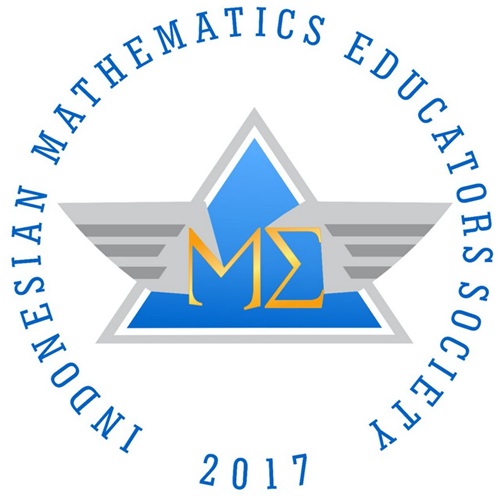Transition of Symbolic-Pictorial Representation in Solving Mathematics Problems
DOI:
https://doi.org/10.22437/edumatica.v12i01.15291Keywords:
pictorial representation, representation transition, symbolic representationAbstract
The purpose of this study is to describe the transition process of symbolic-pictorial representation in solving mathematical problems. Data collection is done by giving written questions which are then followed by structured interviews. The subjects in this study involved seventh grade students who were selected with the consideration that the answers could provide a representations transition process. The results of this study indicate two representations transition processes, namely pictorial to symbolic and symbolic to pictorial. The pictorial-symbolic representation, starting with translating the problem information into the form of an image illustration through the difference in size and number of cakes, integrating the illustrations made through calculations by partitioning them into several equal parts using cutting lines as a modification/simplification process. Symbolic-pictorial representation, shown by finding the key to the problem "cakes are given evenly to 20 people" and translating the information into the form of calculations, then transforms by simplifying the calculation results based on the problem key, the results are translated into an illustrated circle-shaped image which is modified by partitioning it into several parts. The representation relationship shown through the form of symbolic calculations with picture illustrations has the same solution or not. Thus, the difference in the transition process of this representation is in the integration and translation stages of transformation and modification through changing physical forms (illustration of images) and symbols (calculations).
Downloads
References
Boonen, A. J. H., van Wesel, F., Jolles, J., & vander Schoot, M. (2014). The Role of Visual Representation Type, Spatial Ability, and Reading Comprehension in Word Problem Solving: An Item-Level Analysis in Elementary School Children. International Journal of Educational Research, 68(1), 15-26. https://doi.org/https://doi.org/10.1016/j.ijer.2014.08.001
Boonen, A. J. H., de Koning, B. B., Jolles, J., & van der Schoot, M. (2016). Word Problem Solving in Contemporary Math Education: A Plea for Reading Comprehension Skills Training. Frontiers in Psychology, 7, 1-10. https://doi.org/10.3389/fpsyg.2016.00191
Cankoy, O., & Ozder, H. (2011). The Influence of Visual Representation and Context on Mathematical Word Problem Solving. Pamukkale University Journal of Education, 2(30), 91-100. http://pauegitimdergi.pau.edu.tr/Makaleler/745832325_91-100.pdf
Cope, L. (2015). DONE- Math Manipulatives : Making the Abstract Tangible. Delta Journal of Education, 5(1), 10-19. https://www.academia.edu/19886655/Math_Manipulatives_Making_the_Abstract_Tangible
Fatqurhohman, F. (2016). Transition Process of Procedural to Conceptual Understanding in Solving Mathematical Problems. International Education Studies, 9(9), 182. https://doi.org/10.5539/ies.v9n9p182
Fatqurhohman, F. (2021). Characteristics of Students In Resolving Word Problems Based on Gender. Journal of Education and Learning Mathematics Research (JELMaR), 2(1), 1-10. https://doi.org/10.37303/jelmar.v2i1.42
Fatqurhohman, Sa’dijah, C., Irawan, E. B., & Sulandra, I. M. (2017). Representation of Secondary School Students in Solving Fractions. International Journal of Innovation in Science and Mathematics, 5(6), 172-176. http://ijism.org/administrator/components/com_jresearch/files/publications/IJISM_694_FINAL.pdf
Fatqurhohman, Sa’dijah, C., Sudirman, & Sulandra, I. M. (2020). Pictorial of representation in solving word problems. International Journal of Scientific and Technology Research, 9(3), 1057-1060. https://www.ijstr.org/final-print/mar2020/Pictorial-Of-Representation-In-Solving-Word-Problems.pdf
Istadi, Kusmayadi, T. A., & Sujadi, I. (2017). Students’ mathematical representations on secondary school in solving trigonometric problems. Journal of Physics: Conference Series, 855(1). https://doi.org/10.1088/1742-6596/855/1/012021
Noordin, N., Razak, F. A., Dollah, R., & Alias, R. (2012). Identifying Equivalent Pictorial Representation of a Fraction & a Whole: A Problem for 13-year Olds in Malaysia. Procedia - Social and Behavioral Sciences, 42(July 2010), 106-116. https://doi.org/10.1016/j.sbspro.2012.04.172
Phillips, C. G. (2015). An improved representation of mathematical modelling for teaching, learning and research. International Journal of Innovation in Science and Mathematics Education, 23(4), 51-63. https://core.ac.uk/download/pdf/229408339.pdf
Sahendra, A., Budiarto, M. T., & Fuad, Y. (2018). Students’ Representation in Mathematical Word Problem-Solving: Exploring Students’ Self-efficacy. Journal of Physics: Conference Series, 947(1), 1-5. https://doi.org/10.1088/1742-6596/947/1/012059
Sales, J. G., Ramirez, N. K., & Tindowen, D. J. (2019). Students’ Difficulties in Translating Mathematics Word Statements. Journal of Humanities and Education Development, 1(1), 2581-8651. https://www.mathworksheets4kids.co
Sanwidi, A. (2018). Students’ Representation in Solving Word Problem. Infinity Journal, 7(2), 147-153. https://doi.org/10.22460/infinity.v7i2.p147-154
Sari, D. P., Meifiani, N. I., & Suryatin. (2020). Pengaruh Gender terhadap Hasil Belajar Siswa Kelas V MI Al-Huda Ploso Tahun Pelajaran 2019/2020. 1-7. http://repository.stkippacitan.ac.id/id/eprint/314
van Lieshout, E. C. D. M., & Xenidou-Dervou, I. (2018). Pictorial representations of simple arithmetic problems are not always helpful: a cognitive load perspective. Educational Studies in Mathematics, 98(1), 39-55. https://doi.org/10.1007/s10649-017-9802-3
Downloads
Published
How to Cite
Issue
Section
License
Copyright (c) 2022 Fatqurhohman Fatqurhohman

This work is licensed under a Creative Commons Attribution-NonCommercial-ShareAlike 4.0 International License.







